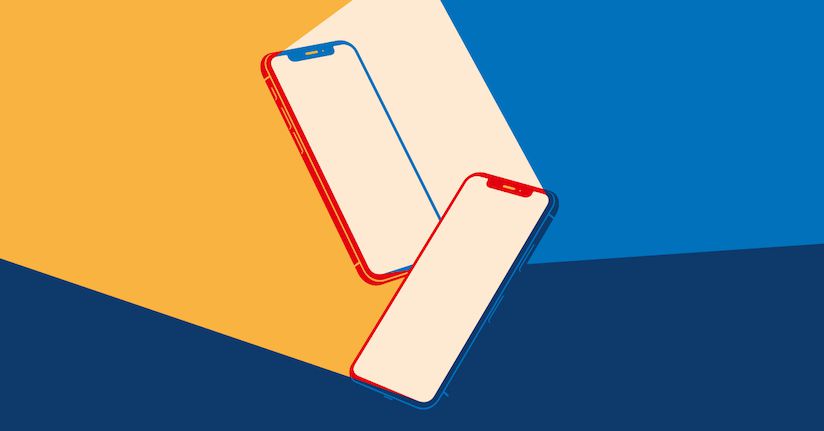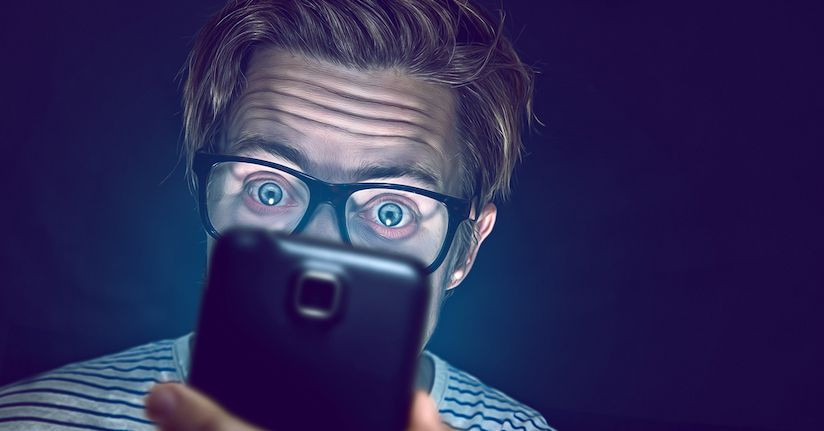Here's Why Smartphones Can Hurt Our Eyes and Cause Headaches
We don’t really know how many of us experience headaches or other eye problems from the use (or abuse) of smartphones; but it is generally accepted that extended screen time from any device can harm our eyes and brain. Among the myriad of physical symptoms, looking at your phone screen might cause:
- Eye strain or fatigue
- Eye pain or inflammation
- Blurry or impaired vision
- Eye dryness
- Blinking dysfunction
- Headaches
- Migraines
- Light sensitivity or photophobia
With the ever-increasing adoption of mobile device technology into our daily lives, it is important to understand how it might cause us pain. We have identified several scenarios that have been shown to bring on smartphone headaches, migraine attacks and ocular symptoms through direct screen viewing.
Spending too long continuously on your device
Even for healthy eyes and brains, staring at your phone screen for a lengthy period of time can lead to headaches and/or eye symptoms for nearly one-third of people.1 The earliest signs of digital eye strain (including eye fatigue and dryness) have been shown to develop after just an hour of extended exposure, and they become even more severe at four hours or longer.2 And it’s important to note that the more you use your mobile device, both on a daily basis and over time, the more likely you are to have multiple ocular symptoms—perhaps as many as seven different ones!3
Clearly, focusing on a backlit screen places stress on our visual systems that simply does not exist when performing the same task without the artificial light. Some of this may also be impacted by the specific settings (e.g. font size) at which we keep our devices as well as other factors like screen glare.

Being intolerant or otherwise sensitive to screen light
It is well established that people with certain disorders like migraine or concussion are activated by artificial light exposure, especially from a mobile screen. Although studies are mixed about the likelihood of smartphone headaches for people without an underlying condition, there has been a direct link between phone screen usage and the risk of migraine. And people with migraine and tension-type headache are also more likely to experience additional symptoms associated with over-exposure to their devices.4,5
This occurs for two main reasons; the first is that their condition leads to a diminished tolerance for light and thus causes photophobia or brain hyper-reactivity. This is often why they may complain that light is "too bright" even at relatively normal levels. The other reason has to do with sensitivity to blue light; although these wavelengths of light affect all of us, research shows they more strongly activate a light-sensitive person.6 We also cannot discount the role of motion sensitivity in the symptoms a user experiences.
Having poor neck and body posture during use
You might not think that the posture with which you look at your cell phone or mobile device would affect your eye strain or headaches, but that is just simply not true. For example, people with migraine often report that neck discomfort is at least a symptom of attacks and could even function as a trigger.7 Even without the presence of an underlying condition, neck and spine issues have been independently associated with excessive cell phone use.8 In addition, there is a unique condition called occipital neuralgia, which occurs when nerves in your spine become compressed and cause radiating headaches and other pain. Believe it or not, craning your neck to view your smartphone screen may lead to this scary issue!

Staring at a bright smartphone screen in the dark
Have you ever noticed that your eyes struggle to adapt to a bright screen in low-light conditions? When we look at our cell phones at night, we risk bringing on health issues that are not as prominent in more appropriate lighting. In fact, even after just 20 minutes of screen exposure in the dark, we can experience significantly more symptoms of eye strain—such as dry eyes, burning sensations, and light sensitivity.9 Next day headaches and fatigue are also common, some of which may also be mitigated by blue light exposure.
Amazingly, 90% of young people keep their smartphones next to their bed and use it during the night without any brightness or lighting adjustments. That makes this a more common problem than we may realize.
How can you reduce your sensitivity to phone screen light?
Let's face it: we don't want to give up our smartphones because they are too much a part of our daily routines. Thankfully there are options for reducing your sensitivity to mobile screen light and decreasing the amount of headaches and eye problems you are experiencing. Below are a couple of articles that offer easy tips for big improvements.
12 Smartphone Hacks to Reduce Headaches and Migraines ➜
How to Make Social Media More Accessible for Light Sensitivity ➜
References:
1Kıvanç, SA, et al. Relation between Smartphone Use and Unilateral Ocular Pain and Headache. Current Perspectives on Less-known Aspects of Headache. 2017 Apr 12;4:77-84. DOI: 10.5772/66624.
2Choi JH, et al. The influences of smartphone use on the status of the tear film and ocular surface. PLoS One. 2018 Oct 31;13(10):e0206541. doi: 10.1371/journal.pone.0206541. eCollection 2018.
3Kim J, et al. Association between Exposure to Smartphones and Ocular Health in Adolescents. Ophthalmic Epidemiol. 2016 Aug;23(4):269-76. doi: 10.3109/09286586.2015.1136652. Epub 2016 Jun 2.
4Montagni I, Guichard E, Carpenet C, Tzourio C, Kurth T. Screen time exposure and reporting of headaches in young adults: A cross-sectional study. Cephalalgia. 2016 Oct;36(11):1020-1027. doi: 10.1177/0333102415620286. Epub 2016 Jul 19.
5Cerutti R, Presaghi F, Spensieri V, Valastro C, Guidetti V. The Potential Impact of Internet and Mobile Use on Headache and Other Somatic Symptoms in Adolescence. A Population-Based Cross-Sectional Study. Headache. 2016 Jul;56(7):1161-70. doi: 10.1111/head.12840. Epub 2016 Jun 3.
6M. Tatsumoto, T. Eda, T. Ishikawa, M. Ayama, K. Hirata. Light of Intrinsically Photosensitive Retinal Ganglion Cell (ipRGC) Causing Migraine Headache Exacerbation. IHC symposium OR3. 2013 June.
7Pradhan S, Choudhury SS. Clinical characterization of neck pain in migraine. Neurol India. 2018 Mar-Apr;66(2):377-384. doi: 10.4103/0028-3886.227302.
8Berolo S, Wells RP, Amick BC 3rd. Musculoskeletal symptoms among mobile hand-held device users and their relationship to device use: A preliminary study in a Canadian university population. Appl Ergon. 2011 Jan;42(2):371-8. doi: 10.1016/j.apergo.2010.08.010. Epub 2010 Sep 15.
9Antona B, et al. Symptoms associated with reading from a smartphone in conditions of light and dark. Appl Ergon. 2018 Apr;68:12-17. doi: 10.1016/j.apergo.2017.10.014. Epub 2017 Nov 2.
TheraSpecs Glasses for Light Management
Try our light-filtering glasses and stay protected against harsh light from screens, fluorescents, LEDs, unwanted blue light, bright sunlight, flashing lights, and more.





